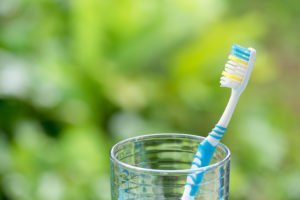How Complicated Does A Toothbrush Have To Be?
 It wasn’t all that long ago that the standard brush was a set of soft, plastic bristles all set up in a few rows and all the same length. But over time, that changed: manufacturers added color bands that would fade when it came time to replace your toothbrush, they added angles to make it easier for the bristles to get in between the teeth, they added rubber bristles to the edge to rub the gums, and they thickened the handle to make it easier to hold. And all that’s just for manual brushes.
It wasn’t all that long ago that the standard brush was a set of soft, plastic bristles all set up in a few rows and all the same length. But over time, that changed: manufacturers added color bands that would fade when it came time to replace your toothbrush, they added angles to make it easier for the bristles to get in between the teeth, they added rubber bristles to the edge to rub the gums, and they thickened the handle to make it easier to hold. And all that’s just for manual brushes.
Then there’s the oscillating-repeating brush, better known as the electric toothbrush. It offers a few benefits over even the most over-designed manual brush, at least to some people:
- The thick handle and the fact that the brush does all the scrubbing for you mean the electric toothbrush is good for people who have trouble moving their hands.
- Electric brushes usually come with a timer or some kind of reminder that lets the user know to keep brushing until it turns off.
Along with that, several long-term studies have shown that electric toothbrushes are just as safe and easy on the teeth as normal brushes, so you don’t have to worry about the electric motor scrubbing so hard that it scrapes some enamel away or harms the gums.
However, no matter what kind of brush you use or how advanced its design may be, the critical element of tooth brushing is the same as it’s always been: technique. The best way to avoid cavities is not to have the best brush, but to have the best technique. That means:
1. Brush twice per day, preferably right after meals.
2. Use toothpaste with fluoride: other ingredients might help, but none are nearly as important.
3. Move the brush at a 45-degree angle to your gums and take your time with each tooth. When you get to the inside of your front teeth, go all the way up to vertical.
4. Brush the inside, outside, and surfaces of all your teeth.
5. Don’t forget to floss, and don’t forget to dig in right to the base of each tooth on each side.
If your technique is good, it won’t matter if you use the cheapest toothbrush you can find: you’ll be able to get all the plaque off every tooth. A better brush can help make things easier, but a good technique is the best way to avoid cavities.